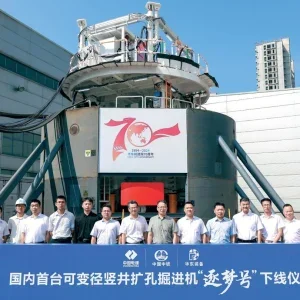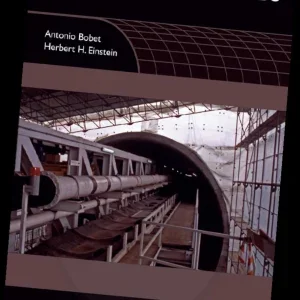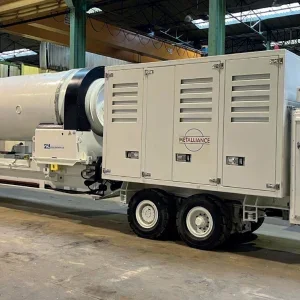A problem that often causes trouble in segmentally lined TBM-driven tunnels is that the front face of the erected ring ceases to be a flat plane. The problem is attributable to the differing forces applied by the TBM shove-rams around the perimeter of the rings, and to Murphy’s Law. All things being equal, in accordance with this Law, the problem will be worse on projects where water-tightness is critical, with stiff, resilient gaskets that tend to open the circle joints, or where a single pass liner is being used, and segment integrity is crucial. If nothing is done about it, the effects on the liner can include leakage, because the joints can’t close properly, and cracked segments, typically with the corners breaking off.
This subject came up for discussion during a working lunch (it wasn’t meant to be a working lunch…) for members of Hatch Mott MacDonald‘s construction management team for the Arrowhead Tunnels project, which is currently under construction in Southern California.
John Townsend, Hatch Mott MacDonald’s resident engineer on the Arrowheads, explained that he had tried for years to come up with a good solution to the problem. The basis of any solution is to take a series of measurements to the face of the ring from a known plane surface on the TBM itself, i.e. the bulkhead, or a series of points around the tailskin established by survey methods. Having taken the measurements, it is then necessary to fit a theoretical plane to them, which will typically not be square to the tunnel axis (it certainly won’t be if tapered rings are being used). Having determined a best-fit plane, the next step is to decide which areas are “low”, and then pack them with thin plywood. Typically 2mm and 3mm ply are used in combination, allowing every integer value above 2mm to be achieved. The trouble is, that the tasks of both fitting a plane to a zigzag surface, and afterwards deciding exactly how to pack it flat, are difficult, and take both time and skill.
On the Storebaelt Project, Mott MacDonald engineer Colin Lawrence had to determine what packing to use, after the contractor said it would take a team of surveyors five hours to do. Colin used a graphical method, amounting to fitting a sine-wave (the line where an inclined plane crosses the a developed picture of the tunnel extrados will be a sine-wave) to a series of measurements. He got this down to 25 minutes.
On some projects the TBM manufacturer supplies a physical model, which checks planarity. This comprises a small table made of Plexiglas, with a circle of holes drilled through it, in which are steel needles that can be adjusted to reflect the differences between a series of measurements to the liner ring. After the needles are adjusted, a second piece of Plexiglas is placed on top. Any gaps between the top Plexiglas and the needles will indicate areas that need packing.
Another method tried was the use of a 3D CAD system to position a plane on a drawn-up surface, but this was not a success and anyway took too long.
All these methods have the disadvantage that they take time, as well as considerable skill, especially if they are to be done in a noisy tunnel. It is also not easy to determine exactly how long the packing pieces should be, especially if you consider that wooden packing will compress under shove-forces, and that these will often be higher at the invert than the crown.
As a result of these difficulties, the problem is often ignored, and the author is aware of one tunnel where the contractor regarded cracked segments as an inevitable consequence of their use, and ended up spending six months doing repairs with epoxy mortar.
At the end of these cheerful discussions over lunch, it was decided to develop a mathematical method of calculating packing requirements. Because of the complexity, not to mention the sheer number of the calculations involved, it was realised that a computer-based solution was the only way to do this.
A computer program has now been developed to solve the problem. Called RingPack, it is a stand-alone executable program that will run under most versions of Windows. It has been designed to be easy to use, and to require no skill to use, except an understanding of the problem itself. It provides an on-screen graphics display of exactly what packing to install, and where to put it, and it will also produce printed reports, in colour if a colour printer is available, which are designed to be given straight to the miners.
The program will use up to three different thickness of packing in combination to give the flattest finished surface possible, and can allow for compression of the packing which varies linearly from crown to invert.
The program was designed to not require any manuals to use, and has operating instructions built into it. On the basis that RingPack was meant to be self explanatory, the user interface, printed reports, and compiled-in instructions are shown.
Technical aspects
The user doesn’t need to know exactly how the program works, but for those with a technical interest:
The program is now in use on the Arrowhead East Tunnel. It works well, and the contractor, Shea/Kenny JV, will be installing it on the computer in the TBM Control Cabin that is used for the VMT Guidance System.
The bulkhead on the Herrenknecht TBM has been checked for planarity by measuring the distance from the bulkhead to the machined joint, half way along the main shield, which is assumed to be flat.
The major difficulty in the use of the system has proven to be that of making accurate measurements between the segments and the TBM bulkhead. Trying to measure to millimetre accuracy using an ordinary steel tape requires both patience and skill, not to mention considerable agility. The contractor has also tried an electronic laser measurement device, which suffers from the problem that it is hard to be sure the measurement being made is truly square to the bulkhead (as if it is not, the measurements will be too big, indicating extra packing is needed). Currently the contractor is investigating the use of a telescopic measurement rod, hoping that this relatively low-tech system will offer more physical robustness, plus making it easier to see that the measurement is truly square to the bulkhead.
Development of the program continues, but meanwhile it is offered absolutely FREE to anyone who would like a copy to try out (see box, upper right). The plan is to make the system as useful as possible; so all suggestions for any improvements are welcome.






